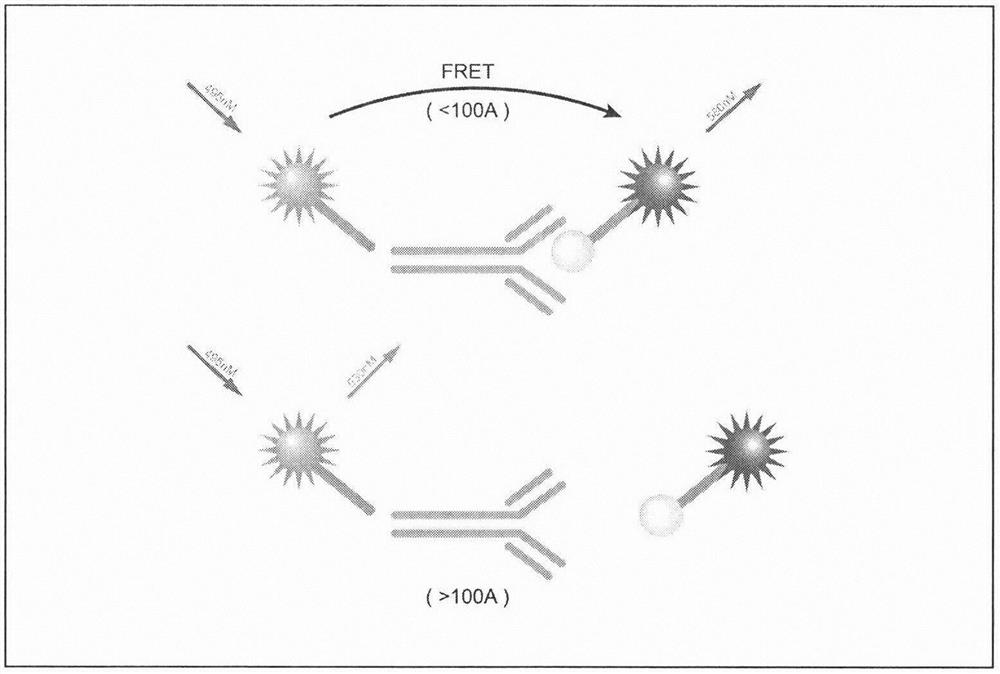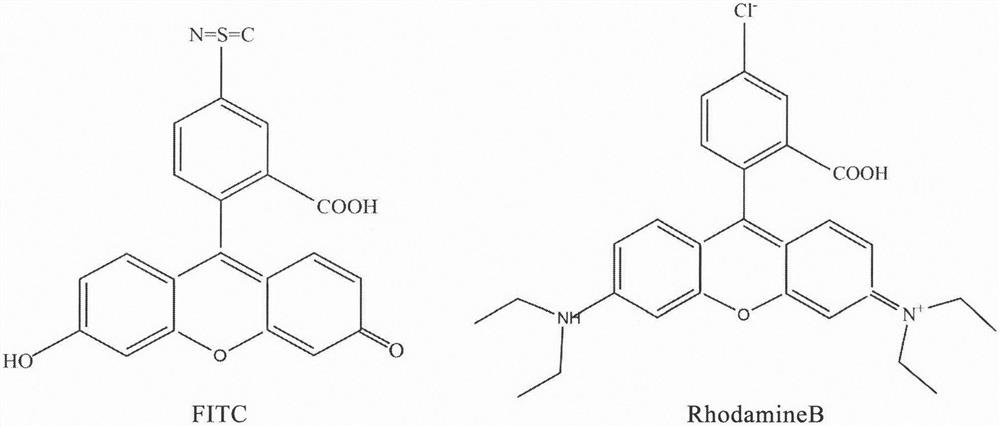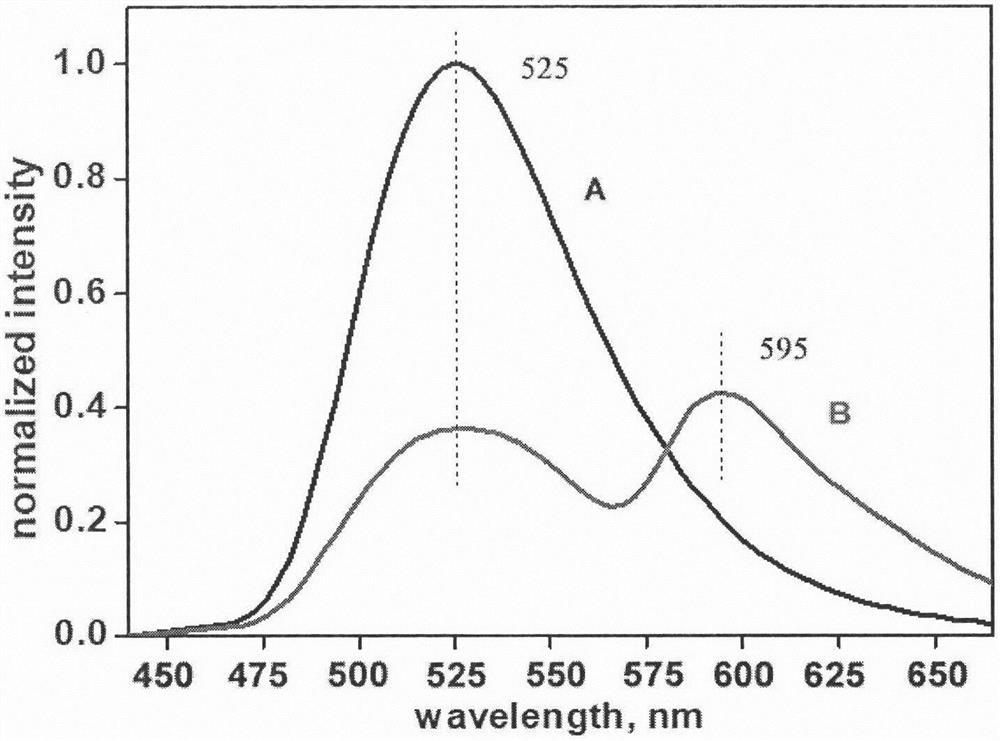Method for detecting interaction of antigen and antibody by using FRET (Fluorescence Resonance Energy Transfer) technology
An antigen-antibody technology, applied in measuring devices, biological testing, material inspection products, etc., can solve the problems of operation errors affecting the experimental results, complicated work and long time, etc., to achieve clear chemical composition and dosage, fast detection time, and time-sensitive fast effect
- Summary
- Abstract
- Description
- Claims
- Application Information
AI Technical Summary
Problems solved by technology
Method used
Image
Examples
Embodiment 1
[0027] Example 1: Labeling the pretreatment-activated fluorescein group with the protein to be tested
[0028] 1. Prepare 20mMPBS (containing 15mMNacl) phosphate buffer: 1LNa2HPO4(12H2O) is alkaline and 1LNaH2PO4(2H2O) is acidic, mix them together, adjust the pH to 7.2, total 2L, add chlorination according to 2L*15mMNacl=0.03molNacl Sodium powder, filter the prepared solution through filter paper for later use.
[0029] 2. Pretreatment of rhodamine B fluorescein: take 1 mg of rhodamine B powder and dissolve it in 1 ml of 20 mMPBS (containing 15 mM Nacl) phosphate buffer saline and MES solution in a mixed solution. ml of RB solution, mixed according to the molar ratio RB:EDC:NHS=1:1.2:1.2, and activated at room temperature for 4 hours in the dark.
[0030]3. Rhodamine B and PCT antigen labeling: Take 1ml of the purified PCT antigen with a concentration of 1mg / ml and dialyze it once every 3 hours with 20mMPBS (containing 15mM Nacl) solution at 4°C, for a total of three times. ...
Embodiment 2
[0032] Embodiment 2: Sephadex G-25 molecular sieve screening purification
[0033] 1. Column packing: Pack the column overnight one day in advance, put the swollen dextran gel into a circular glass column with a diameter of 1.5 cm, the liquid height is about 12 cm, and settle overnight at 4°C.
[0034] 2. Column equilibration: Use 80-100ml of double distilled water to pass through the column to wash away the 75% ethanol solution, and then use 80-100ml of 20mMPBS (containing 15mM Nacl) phosphate solution to equilibrate the column.
[0035] 3. Sample loading: Avoid light during the sample loading process, and add the sample when the equilibrium solution in the column is flush with the top layer of the gel.
[0036] 4. Elution: Use the balance solution as the eluent to elute the sample, and the labeling is successful. It can be seen that after the eluent is added, the column is divided into three colors: upper, middle and lower. The upper layer is darker fluorescein, and the midd...
Embodiment 3
[0037] Embodiment 3: Multifunctional microplate reader detects fluorescence intensity
[0038] 1. Detection of FITC-PCT antibody labeling rate: Take 100ul of the screened FITC-PCT antibody solution in a cuvette, measure the absorbance at 495nm and 280nm, and calculate the F / P molar ratio. Formula: Molar F / P =[2.77×A495] / [A280-(0.35×A495)] calculation, the ratio is about 1, indicating higher efficiency.
[0039] 2. FRET technology to detect PCT antigen-antibody interaction: using a multi-functional microplate reader, add 100ulFITC-PCT antibody to a well in a 96-well plate, and detect the fluorescence spectrum and intensity at 495nm excitation and 530nm emission wavelength; in the 96-well plate Add 100ulFITC-PCT antibody and 100ulRB-PCT antigen solution to the second well, mix well, react at room temperature in the dark for 20min, and detect the fluorescence spectrum and intensity at 495nm excitation and 580nm emission wavelength.
[0040] 3. After statistical analysis of the f...
PUM
 Login to View More
Login to View More Abstract
Description
Claims
Application Information
 Login to View More
Login to View More - R&D
- Intellectual Property
- Life Sciences
- Materials
- Tech Scout
- Unparalleled Data Quality
- Higher Quality Content
- 60% Fewer Hallucinations
Browse by: Latest US Patents, China's latest patents, Technical Efficacy Thesaurus, Application Domain, Technology Topic, Popular Technical Reports.
© 2025 PatSnap. All rights reserved.Legal|Privacy policy|Modern Slavery Act Transparency Statement|Sitemap|About US| Contact US: help@patsnap.com



